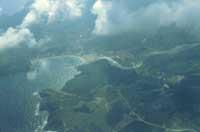The destruction of the rocks of Euskal Herria and Mexico 65 million years ago
2000/04/01 Nuñez-Betelu, Koldo Iturria: Elhuyar aldizkaria
Sedimentary rocks emerge everywhere in Euskal Herria. Many of these rocks have been formed in the sand of the sea, by progressive accumulation of sediments. The accumulated sediments are minerals, skeletons and mineralized shells of different microbeings, organic remains, etc. In the deep sea, away from the coast, sediments accumulate very regularly for millions of uninterrupted years. The rocks that form in this type of zone, if not transformed through great pressures and heat, retain the original components that allow to obtain a highly appreciated information, since they become ancient witnesses. Thus, the planktonic microbeings that inhabit the sea are born to the bottom like a mineral sirimiri when dying, where the shells of the foraminifers accumulate, the cysts of the dinoflagelados and the components of the skeletons of lime nanofossils, among others. These microbeings are very sensitive to what can happen in the environment. They are also rapidly evolving. Therefore, analyzing the fossil remains of microbeings and the characteristics of coastal sedimentary rocks, we can deduce some data from the past such as paleoclimatology, paleogeography, etc.
Cretaceous ended some 65 million years ago. The end was not despicable, as it was then that many of the creatures who lived were destroyed. The dinosaurs we all know lived in the world from pole to pole for millions of years. In the temperate seas, giant reptiles and ammonite snails of the Chipirones family lived deeply during the Cretaceous. These and many others disappeared in a geological lipar. In recent decades, numerous resolution hypotheses have been formulated, of which two have been imposed. According to the first, the mass murder was due to a series of destruction and consequences caused by a meteorite or a giant comet, about ten kilometers from outer space. On the contrary, the second hypothesis maintains: That at the end of the Cretaceous the great volcanic eruptions in present-day India could be the basis of destruction.
Over the past 20 years, numerous tests of support for fireball from abroad have been found around the world. One of the last would be the crater formed by the collision. This has appeared in the subsoil of the Yukatan Peninsula in Mexico. Therefore, this town is very interesting to investigate what happened at the end of the Cretaceous. In fact, in northeastern Mexico there are very good places where the rocks of the Cretaceous emerge. In it, rocks can be investigated and samples collected, once treated in laboratory, for study by microscopy.
On the other hand, most of the current Euskal Herria was covered by deep seas at the end of the Cretaceous. The sediments accumulated then and the rocks that were formed below, today are emerging in many places, being the Basque-Cantabrian Basin one of the most important in the world for this type of research.
Our team has already done a great job in Euskal Herria, with promising results and great experience. Therefore, it is a good time to compare the information of Euskal Herria with that of Mexico. But it is not a mere comparative analysis, but a tool to deepen existing knowledge. To this end, this project has a duration of three years. Moreover, the work already done has created relationships and links with other researchers around the world. Thus, researchers from the UPV-EHU and the University of Huelva will accompany us in this project researchers from France, Germany, USA and Mexico.

Gai honi buruzko eduki gehiago
Elhuyarrek garatutako teknologia





